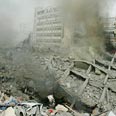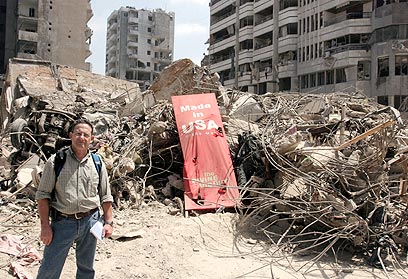
In Nasrallah’s neighborhood
Nasrallah’s men guard the entrance to Dahiya quarter in southern Beirut and decide whom to admit. Neighborhood looks like it was hit by an earthquake; shocked residents scrounge among destroyed buildings for furniture remnants. And the rest of Beirut? No signs of war here
BEIRUT - Just like in any other modern city, Beirut’s streets are filled with morning rush-hour traffic. In fact, with the possible exception of Germany, no other place has this many Mercedeses and BMW’s. The light Mediterranean normalcy surrounding me is at complete odds with Prime Minister Fouad Siniora’s tears at the meeting of Arab foreign ministers.
I rent a room on the sixth floor of the Meridien Commodore hotel in northern Beirut. Twenty six years ago, during the first Lebanon War, the hotel was directly in the line of fire, and we frequently were forced to take shelter in the basement. But the pockmarked hotel of those days bears no resemblance to today’s luxurious edifice.

Ben-Yishai amid rubble in Beirut
Approximately a dozen European and American journalists sit in the dark wood-paneled lobby, drinking espressos and reminiscing. “Go to the Dahiya quarter,” one of them says to me. “There is destruction there like you’ve never seen.”
I hire Rasheed, a young Lebanese with passable English. “I have a motorbike,” he grins. “That’s the most comfortable way to travel in Dahiya among the ruins.”
We zigzag between cars on our way to the Shiite neighborhoods in the city’s South. The poverty and desolation increases as we move southward, and I notice that the population has changed as well.
Bearded men are dressed in modern clothes, but the women are covered from head to toe in Iranian-style black chadors. Giant posters of Iranian leader Khomeini and Nasrallah hang from old multistoried apartment buildings that are in desperate need of repair.
Hizbullah at the gate
Shiites and Palestinians live here, Rasheed explains as we pass the Kuwaiti embassy near Sabra and Shatila. Signs of destruction are everywhere. An entire section is missing from what was once an elevated bridge.
“Welcome to Dahiya,” Rasheed announces and points to a five-story building which has been flattened and is now only a few meters high. “This was Hizbullah’s Islamic College.”
Fetid water flows from a hole in a bombed sewer pipe. Rasheed skillfully skirts several burning cars and an unexploded shell, which some children are curiously examining. As we drive along, we pass more and more damaged houses. I ask Rasheed to bring me to the inner part of Dahiya, where Hizbullah’s offices and blown up bunkers are located.
“I hope they’ll let us in,” he replies with a nod.
At the entrance to a narrow alley in the Harat Hareik neighborhood, between two dilapidated buildings, a young man in black stands guard. He grimly surveys each car and pedestrian seeking to pass. Next to him, four or five unshaven young men crowd into a shed. Two of them sit at a table on white plastic chairs and flip through some papers.
We stop in front of the man in black, who stands in front of broken concrete blocks and twisted metal. This is an entrance to the inner part of Dahiya. One still needs special permission from Hizbullah to enter, just like before the war, but there is a difference.
“Now,” Rasheed whispers, “Hizbullah’s security men don’t carry revealed weapons.”
The accursed town
We head towards southern Lebanon on the next day. The highway from Beirut to the South is mostly empty. Every bridge had been destroyed, and we must ride on narrow and dusty dirt paths. At the major intersections, we observe Lebanese soldiers, but they do not stop and check any vehicles.
During our long trip southward, we do not see even a single armed Hizbullah fighter. Apparently, they simply melted into the general population but continue to keep an eye on their territory. Every so often, they emerge, check documents, and disappear once again.
It takes us two and a half hours to reach Bint Jbeil. On the way, we pass Katyusha launch sites in Qana, Zadikin, and Biatar. Almost every house in these villages was either hit or completely destroyed.
In Bint Jbeil, I learn that the IDF had not entered this giant town but merely encamped on the outskirts. As a result, Hizbullah was able to move freely from bunker to bunker and fire antitank missiles.
At least, that is what a Hizbullah fighter, who refused to be identified, proudly boasts to me. However, apparently unaware of the inherent contradiction in his words, he then proceeds to complain that IDF artillery and the IAF unjustly bombed the town down to its very foundation.
The devastation is south Lebanon is much worse than in Beirut, where basically only Dahiya was damaged. In contrast, hundreds of houses throughout southern Lebanon have been almost completely totaled.
Along the border
From the heights of Maroun al-Ras – or what remains of Maroun al-Ras – we observe IDF soldiers deployed several hundred meters away from us in Lebanese territory; we are also able to make out Avivim’s red roofs. Five Hizbullah men crow about the “defeat of the IDF” to a group of journalists.
On our way from Bint Jbeil to Nequra, we travel on the Lebanese border road which stretches along the length of the Blue Line. Seeing IDF positions from the Lebanese side is bizarre, but I am even more taken aback when we suddenly notice an Israeli tank and an Israeli armored personnel carrier 100 meters in front of us, deep inside Lebanese territory, near the village of Almah al-Shaab.
They do not appear to notice us, and they seem to be easy prey – too easy – for anyone who, like us, happens to be driving on that road.
The sun is about to set. Three French warships and a UN supply ship sail on the sea below. A funeral for two Hizbullah fighters takes place on the white cliff over Nequra, in the village of Dahar al Baidar. We hear the women in black scream and wail, as we turn northward and head out on our long and weary trip back to Beirut and the espresso of the Asharfiya neighborhood.










